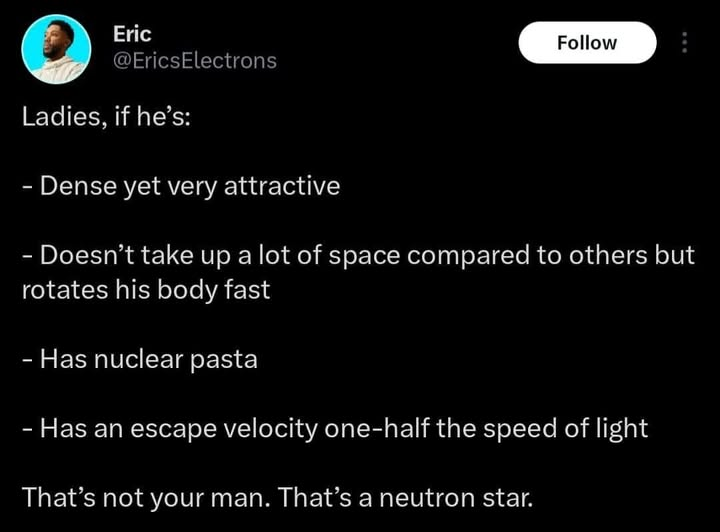I read the first two and thought black holes
Science Memes
Welcome to c/science_memes @ Mander.xyz!
A place for majestic STEMLORD peacocking, as well as memes about the realities of working in a lab.

Rules
- Don't throw mud. Behave like an intellectual and remember the human.
- Keep it rooted (on topic).
- No spam.
- Infographics welcome, get schooled.
This is a science community. We use the Dawkins definition of meme.
Research Committee
Other Mander Communities
Science and Research
Biology and Life Sciences
- !abiogenesis@mander.xyz
- !animal-behavior@mander.xyz
- !anthropology@mander.xyz
- !arachnology@mander.xyz
- !balconygardening@slrpnk.net
- !biodiversity@mander.xyz
- !biology@mander.xyz
- !biophysics@mander.xyz
- !botany@mander.xyz
- !ecology@mander.xyz
- !entomology@mander.xyz
- !fermentation@mander.xyz
- !herpetology@mander.xyz
- !houseplants@mander.xyz
- !medicine@mander.xyz
- !microscopy@mander.xyz
- !mycology@mander.xyz
- !nudibranchs@mander.xyz
- !nutrition@mander.xyz
- !palaeoecology@mander.xyz
- !palaeontology@mander.xyz
- !photosynthesis@mander.xyz
- !plantid@mander.xyz
- !plants@mander.xyz
- !reptiles and amphibians@mander.xyz
Physical Sciences
- !astronomy@mander.xyz
- !chemistry@mander.xyz
- !earthscience@mander.xyz
- !geography@mander.xyz
- !geospatial@mander.xyz
- !nuclear@mander.xyz
- !physics@mander.xyz
- !quantum-computing@mander.xyz
- !spectroscopy@mander.xyz
Humanities and Social Sciences
Practical and Applied Sciences
- !exercise-and sports-science@mander.xyz
- !gardening@mander.xyz
- !self sufficiency@mander.xyz
- !soilscience@slrpnk.net
- !terrariums@mander.xyz
- !timelapse@mander.xyz
Memes
Miscellaneous
Neutron Stars are just black holes with commitment issues
My boy Eric has made it, I remember chatting with him on IG when he had a few hundred followers back in 2021
If the escape velocity is above 1c, isn't it a black hole?
Yes. 1/2 c is super fast still and gravity that strong would have effects like noticably bending outgoing light.
Neutron stars are right on the verge of becoming black holes and are incredible.
And 1/2c is a pretty middle of the road escape velocity for a neutron star.
The lightest known neutron star, at 1.4 solar masses has an escape velocity of right around 1/4c, while the heaviest at 2.35 solar masses is 3/4c.
All of which assumes the neutron star isn't spinning. Equatorial bulging caused by the rotation reduces the escape velocity at the equator relative to the poles and depending on whether or not you launch with the direction of the rotation you might be able to subtract the rotational velocity from your escape velocity.
As an example, in the case of that 2.35 solar mass neutron star, it has a rotational velocity of approximately 0.24c. So of you launch with the rotation you get an escape velocity of 0.5c, whereas if you launch against it you're looking at more like 0.98c.
So technically there could be an object that is mostly a black hole, except on the equator?
